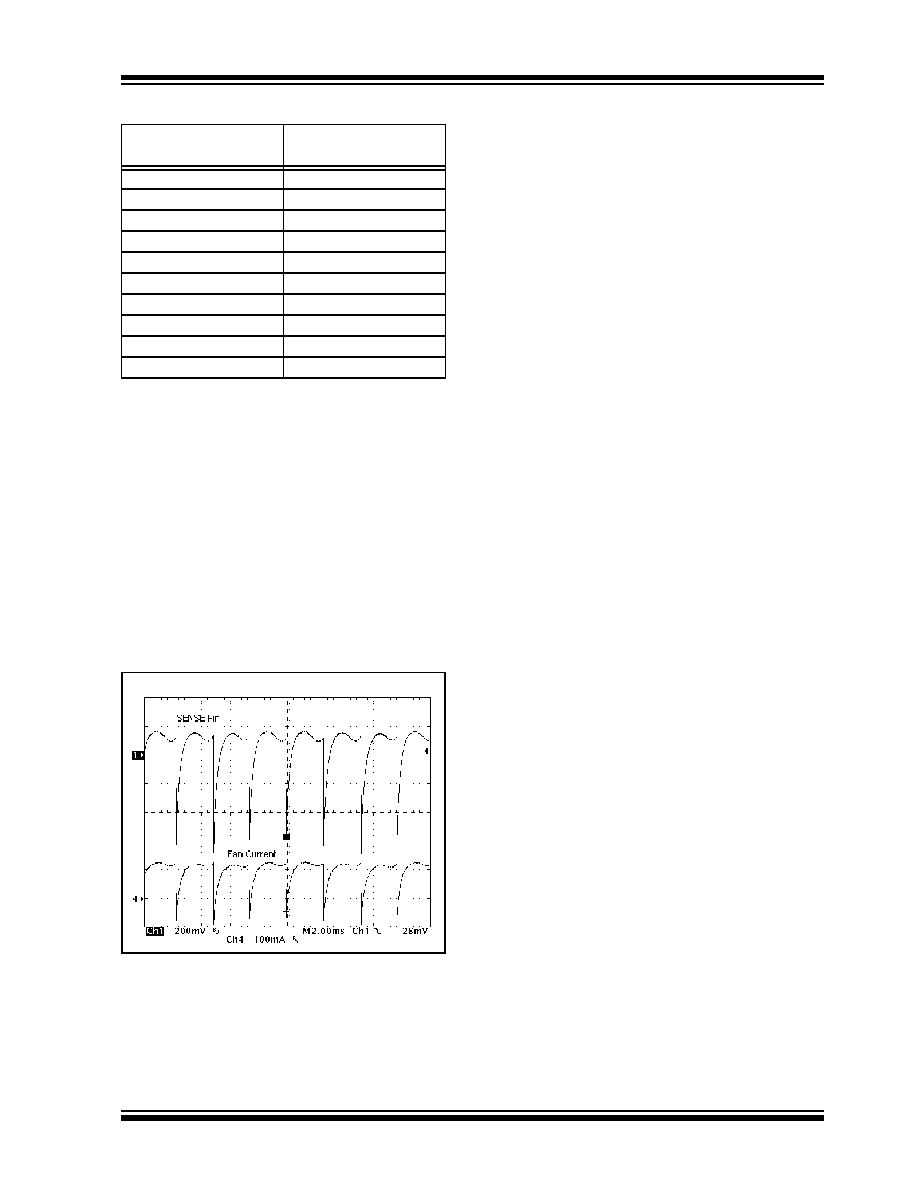- 您現(xiàn)在的位置:買(mǎi)賣(mài)IC網(wǎng) > PDF目錄98170 > TC642BEOA BRUSHLESS DC MOTOR CONTROLLER, PDSO8 PDF資料下載
參數(shù)資料
| 型號(hào): | TC642BEOA |
| 元件分類(lèi): | 運(yùn)動(dòng)控制電子 |
| 英文描述: | BRUSHLESS DC MOTOR CONTROLLER, PDSO8 |
| 封裝: | 0.150 INCH, PLASTIC, SOIC-8 |
| 文件頁(yè)數(shù): | 11/34頁(yè) |
| 文件大?。?/td> | 683K |
| 代理商: | TC642BEOA |
第1頁(yè)第2頁(yè)第3頁(yè)第4頁(yè)第5頁(yè)第6頁(yè)第7頁(yè)第8頁(yè)第9頁(yè)第10頁(yè)當(dāng)前第11頁(yè)第12頁(yè)第13頁(yè)第14頁(yè)第15頁(yè)第16頁(yè)第17頁(yè)第18頁(yè)第19頁(yè)第20頁(yè)第21頁(yè)第22頁(yè)第23頁(yè)第24頁(yè)第25頁(yè)第26頁(yè)第27頁(yè)第28頁(yè)第29頁(yè)第30頁(yè)第31頁(yè)第32頁(yè)第33頁(yè)第34頁(yè)

2003 Microchip Technology Inc.
DS21756B-page 19
TC642B/TC647B
TABLE 5-1:
FAN CURRENT VS. RSENSE
The values listed in Table 5-1 are for fans that have the
fan current waveshape shown in Figure 4-7. With this
waveshape, the average fan current is closer to the
peak value, which requires the resistor value to be
higher. When using a fan that has the fan current wave-
shape shown in Figure 4-6, the resistor value can often
be decreased since the current peaks are higher than
the average and it is the AC portion of the voltage that
gets coupled to the SENSE pin.
The key point when selecting an RSENSE value is to try
to minimize the value in order to minimize the power
dissipation in the resistor. In order to do this, it is critical
to know the waveshape of the fan current and not just
the average value.
Figure 5-4 shows some typical waveforms for the fan
current and the voltage at the SENSE pin.
FIGURE 5-4:
Typical Fan Current and
SENSE Pin Waveforms.
Another important factor to consider when selecting the
RSENSE value is the fan current value during a locked
rotor condition. When a fan is in a locked rotor condition
(fan blades are stopped even though power is being
applied to the fan), the fan current can increase dra-
matically, often 2.5 to 3.0 times the normal operating
fan current. This will effect the power rating of the
RSENSE resistor selected.
When selecting the fan for the application, the current
draw of the fan during a locked rotor condition should
be considered, especially if multiple fans are being
used in the application.
There are two main types of fan designs when looking
at fan current draw during a locked rotor condition.
The first is a fan that will simply draw high DC currents
when put into a locked rotor condition. Many older fans
were designed this way. An example of this is a fan that
draws an average current of 100 mA during normal
operation. In a locked rotor condition, this fan will draw
250 mA of average current. For this design, the
RSENSE power rating must be sized to handle the
250 mA condition. The fan bias supply must also take
this into account.
The second style design, which represents many of the
newer fan designs today, acts to limit the current in a
locked rotor condition by going into a pulse mode of
operation. An example of the fan current waveshape
for this style fan is shown in Figure 5-5. The fan repre-
sented in Figure 5-5 is a Panasonic, 12V, 220 mA fan.
During the on time of the waveform, the fan current is
peaking up to 550 mA. Due to the pulse mode opera-
tion, however, the actual RMS current of the fan is very
near the 220 mA rating. Because of this, the power rat-
ing for the RSENSE resistor does not have to be over-
sized for this application.
Nominal Fan Current
(mA)
RSENSE()
50
9.1
100
4.7
150
3.0
200
2.4
250
2.0
300
1.8
350
1.5
400
1.3
450
1.2
500
1.0
相關(guān)PDF資料 |
PDF描述 |
|---|---|
| TC647EOATR | BRUSHLESS DC MOTOR CONTROLLER, PDSO8 |
| TC647VUATR | BRUSHLESS DC MOTOR CONTROLLER, PDSO8 |
| TC647VOART | BRUSHLESS DC MOTOR CONTROLLER, PDSO8 |
| TC648EOA | BRUSHLESS DC MOTOR CONTROLLER, PDSO8 |
| TC648VOA | BRUSHLESS DC MOTOR CONTROLLER, PDSO8 |
相關(guān)代理商/技術(shù)參數(shù) |
參數(shù)描述 |
|---|---|
| TC642BEOA713 | 功能描述:馬達(dá)/運(yùn)動(dòng)/點(diǎn)火控制器和驅(qū)動(dòng)器 w/Rstrt & Flt Dtct RoHS:否 制造商:STMicroelectronics 產(chǎn)品:Stepper Motor Controllers / Drivers 類(lèi)型:2 Phase Stepper Motor Driver 工作電源電壓:8 V to 45 V 電源電流:0.5 mA 工作溫度:- 25 C to + 125 C 安裝風(fēng)格:SMD/SMT 封裝 / 箱體:HTSSOP-28 封裝:Tube |
| TC642BEOAG | 制造商:Microchip Technology 功能描述:Fan Control Demo Board |
| TC642BEOATR | 制造商:MICROCHIP 制造商全稱:Microchip Technology 功能描述:PWM Fan Speed Controllers With Minimum Fan Speed, Fan Restart and FanSense⑩ Technology for Fault Detection |
| TC642BEPA | 功能描述:馬達(dá)/運(yùn)動(dòng)/點(diǎn)火控制器和驅(qū)動(dòng)器 w/Rstrt & Flt Dtct RoHS:否 制造商:STMicroelectronics 產(chǎn)品:Stepper Motor Controllers / Drivers 類(lèi)型:2 Phase Stepper Motor Driver 工作電源電壓:8 V to 45 V 電源電流:0.5 mA 工作溫度:- 25 C to + 125 C 安裝風(fēng)格:SMD/SMT 封裝 / 箱體:HTSSOP-28 封裝:Tube |
| TC642BEPA713 | 制造商:MICROCHIP 制造商全稱:Microchip Technology 功能描述:PWM Fan Speed Controllers With Minimum Fan Speed, Fan Restart and FanSense⑩ Technology for Fault Detection |
發(fā)布緊急采購(gòu),3分鐘左右您將得到回復(fù)。